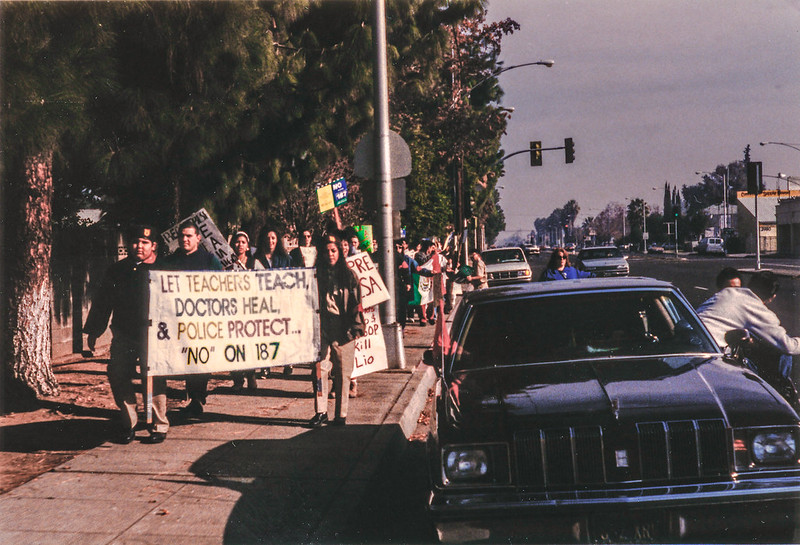
Editors’ note: In this archival post, originally published Nov. 25, 2019, Good Authority contributor Andrea Silva examines how direct democracy – via initiatives and referendums – influences state legislatures’ willingness to tackle immigration policy.
Twenty-five years ago, voters in California passed Proposition 187. This initiative, called “Save Our State,” denied public, social, educational, and health services to undocumented immigrants in California. At the time, its proponents argued the initiative responded to federal inaction on immigration policy and the financial burden undocumented immigrants placed on the state. Although never enforced, Proposition 187’s regulations remained in effect for 20 years, until California’s legislature completely repealed it.
But Proposition 187 was not the last attempt by states to set immigration policy. Since 1994, citizens in many states have continued to use direct democracy mechanisms like ballot initiatives to pass immigration policies. In 2006, Arizona voters passed propositions that deny bail and punitive damages to unauthorized migrants. In 1998 and 2008, respectively, Californians passed English-only education policies and eliminated bail for arrested unauthorized immigrants. Oregon voters repealed laws that allowed such immigrants to get driver’s licenses. Since 1994, 65 initiatives and referendums to change state immigration laws were attempted via direct democracy mechanisms.
Why are states so involved in immigration policy? Certainly, part of the reason is that Congress has taken little to no action in enacting immigration legislation. State governments are responding to a variety of local factors, such as increasing racial and ethnic diversity, economic trends, and shifts in which party controls the legislature and governorship.
When states offer ballot initiatives, their legislatures are more likely to tackle immigration
My research suggests another factor at work: direct democracy. Counting all immigration-related policies enacted by state legislatures from 1990 to 2014, I found legislators in the 21 states with ballot initiatives passed one more immigration-related law per year than states that did not enable citizens to make law by popular initiative. In other words, the mere presence of ballot initiatives was correlated with state legislatures enrolling state immigration laws.
Why? One key reason is that direct democracy changes incentives for legislators and citizens. Legislators know if they don’t act, citizens or other interests could pursue direct democracy as an alternative. State legislators may pass immigration legislation to ensure they, not citizens, control policymaking. They may also hope to use legislation to promote themselves to their constituents, since passing or even introducing state immigration bills allows legislators to seem productive on a timely issue. Proposition 187 was one example: Gov. Pete Wilson made the fight against undocumented immigrants a central theme in his 1994 reelection campaign.
But citizens — especially activists — may nevertheless prefer to put initiatives on the ballot. Legislators negotiate various points with one another; to avoid that, some activists aim instead for an up-or-down vote on their proposals “as is.” Even some legislators may prefer to propose a bill directly to the voters, to keep other citizens or legislators from “meddling.” Proposition 187 offers an example here, too. Assemblyman Richard L. Mountjoy, who had spent years attempting to submit different immigration bills, became convinced that the only way to get what he wanted was via a constitutional initiative. He worked with four citizens to submit Proposition 187 in 1994.
Citizens who try to get immigration-related initiatives on the ballot are often trying to make state policy more restrictive. For example, of the 13 immigration initiatives submitted in California between 2003 and 2018, most tried to restrict immigrants’ rights or encourage state and local authorities to comply and cooperate with the federal immigration enforcement policy. Four of these initiatives were submitted by the same person.
Even though most of these initiatives failed to qualify for the ballot, their presence highlights three realities. First, states — via direct democracy or the legislature — are making efforts on immigration policy while Congress is not. Second, activists — some with little to no policy experience — are using initiatives to bypass the legislature and introduce immigration policy. Third, as comprehensive immigration policy is on hold in Congress, states, localities, and the executive branch are setting the tone of future discussions and policy on immigration.
Why do state immigration-related laws matter?
Although the federal government controls U.S. immigration policy, states have a lot of power over policies that affect immigrants’ lives, including education and public safety.
What’s more, state immigration-related policies can also influence federal policy. For example, the passage of Proposition 187 spurned other states to consider copycat laws, and some of its main ideas and justifications were included in congressional debates about the Illegal Immigration Reform and Immigrant Responsibility Act of 1996. For instance, that act’s three main goals were also those of Proposition 187: border control, controlling legal entry, and interior enforcement. Another aspect of Proposition 187 involved making it harder for noncitizens to get state and local benefits like non-emergency health care and access to public schooling. The federal government followed suit in the 1996 Personal Responsibility and Work Opportunity Reconciliation Act, where it barred legal immigrants from accessing public health and welfare assistance for a number of years.
Citizens continue to try to pass immigration initiatives
Just this month, Nov. 2019, the city of Tucson voted on city Proposition 205 to declare Tucson a “sanctuary city” — a measure that lost with just under 30 percent of the vote. In 2020, California groups are sponsoring an initiative to repeal the state’s 2017 sanctuary law — a rerun of an initiative that failed in 2018. Expect states and cities to keep trying to make immigration policy, pushing the federal government to take different stances.
Image: (cc) Thomas Hawk



